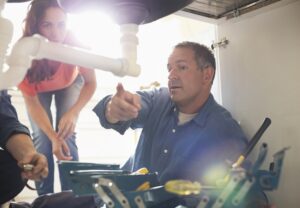A leak in your commercial bathroom can lead to a cascade of problems, from water damage to mold growth. Detecting and addressing leaks promptly is crucial to avoid costly repairs. In this guide, we’ll explore ways to identify bathroom leaks and offer some DIY tips for temporary solutions. However, it’s essential to stress that consulting a professional plumber is vital for a comprehensive and lasting fix.
DIY solutions can only be temporary, and they’ll quickly add to the problem if they’re viewed as permanent. Professional plumbers are the only good solution to a serious leak on your commercial property, so make sure you call for one while you address this problem.
Identifying the Leak
Detecting a bathroom leak early can prevent extensive damage. Look out for signs such as water stains on ceilings or walls, peeling paint or wallpaper, and a musty odor. Check under sinks, around toilets, and inspect the flooring for any warping or discoloration. Even a slight discoloration could mean water is entering areas that it shouldn’t. If you notice these signs, it’s time to investigate further.
Locating the Source
Pinpointing the source of a leak is the first step in addressing the issue. Check for visible leaks under sinks, around toilet bases, and along the edges of the bathtub or shower. Pay attention to dripping sounds or any unusual water pooling. In some cases, leaks may be hidden behind walls or under flooring, requiring a more thorough inspection.
Temporary Solutions for DIYers
While waiting for a professional plumber, there are some temporary fixes you can implement to mitigate damage:
- Cleaning Up the Mess: Water damage can lead to mold growth and other issues, so it’s crucial to clean up promptly:
- Remove Standing Water: Use a wet-dry vacuum or towels to remove any standing water. Adequate ventilation will aid in the drying process.
- Use Dehumidifiers: Dehumidifiers can help reduce moisture levels in the affected area, preventing mold growth.
- Disinfect and Clean: Disinfect surfaces that come into contact with water to prevent mold and bacteria growth. This includes walls, flooring, and any affected belongings.
- When to Call a Plumber: DIY solutions are useful for temporary fixes, but they don’t replace the expertise of a professional plumber. Always call a plumber when:
- The source of the leak is not easily identified.
- The leak is extensive or causing structural damage.
- DIY fixes are not holding or resolving the issue.
Detecting and addressing leaks in your commercial bathroom promptly is essential to prevent further damage and costly repairs. While temporary DIY solutions can help in a pinch, consulting a professional plumber is crucial for a thorough and lasting fix. Remember, when it comes to plumbing issues, it’s better to address the root cause with the help of an experienced plumber to ensure the long-term integrity of your commercial bathroom.
Established in 1912, Max Sr & Paul Schoenwalder Plumbing, Heating and Air Conditioning, A Corp. is your trusted resource for reliable commercial plumbing in Union. Reach out to us today.

